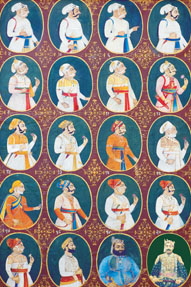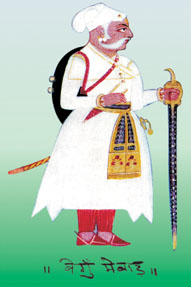| |
|
| |
|
| |
 |
|
Begu was offered to the crown prince of Mewar Prince Chunda ji in 1430 AD. Chunda ji being the eldest son of Maharana Lakha ji, made the supreme sacrifice of abdicating the throne of Mewar in favour of his yet to be born step brother. Begu was one of the oldest fiefs and earned the highest revenue amongst all the fiefs in erstwhile Mewar. At one point Begu comprised of 500 revenue villages which included 04 paraganas (districts). Over a period of time its original boundaries were altered and some nobles branched out from it to form their own jagirs. Glimpses of the history of Begu are documented in the history section of the website www.fortbegu.com
The present owner of the fort Rawat Sawai Hari Singh II opened the gates of the 15th century Fort Begu for tourists. It is now an exquisite heritage hotel.
The old fort of Begu dates back to the 15th century AD. During this long spell, it has witnessed numerous battles. The slot marks of cannon attacks on the four walls and bastions of the fort bear testimony to the heroic deeds of its rulers who put up a stiff resistance to invading Mughal and Maratha forces. Col. James Tod, the famous Scottish historian and political agent of the British Raj in India in the 19th century, wrote in his memorable historic work, Annals and Antiquities of Rajputana that "There is not a petty state in Rajputana that has not had its Thermopylae and scarcely a city that has not produced its Leonidas."
|
|
| The Begu Family Tree |
|
The Fort of Begu is built over an area of 30 acres. A remarkably wide moat encircles it. The entire fort is further strengthened by a double- wall structure. The wall rising from the moat is 10 to 12 feet wide at the base and it gradually tapers at the top. There are 18 bastions around the fort where cannons were placed. The fort has 8 huge gates. The jail (prison) in the south- west corner of the fort last housed its inmates before 1947, after which India gained independence. There are half a dozen elephant stables (peel khana) besides horse stables. On the western side of the fort lie havelis (mansions) once inhabited by the exchequer of the estate, sub vassals of Begu, temple priests and the majordomo of the palace. Inside the fort there is a garden known as Lal Bagh with a centrally located Lal Bagh Kothi (ancient guest house for visiting dignitaries). Also, there are half a dozen temples and two prominent Jain temples besides the main Dwarkadhish temple devoted to Lord Krishna.
There are six kinds of forts in India according to their usage namely Nar durg (city fort), Dhanva durg (desert fort), Mahi durg (mud fort), Jal durg (water fort), Giri fort (hill fort) and Purs (fortified city). Out of these 6 kinds Nar durg is considered the best as it has secret tunnels that provide the dual advantage of an escape route in times of peril and the possibility of replenishing armaments and resources. Fort of Begu is an excellent example of Nar durg.
|
Fort Begu bears a resemblance to that of Agra fort built in 1570 AD by Emperor Akbar. The fort encompasses more than half a dozen courtyards of various sizes of which Mayur Chowk is the most prominent, spread across half an acre. The Char Bagh patterned garden at Mayur Chowk plays host to around 40-50 peacocks and hundreds of parakeets at sunrise and sunset even today.
|
5th Oct 1948
Gaddi Nashini (Investiture ceremony) |
1956 AD |
Rawat Sawai Hari Singh II of Begu
(26 Sep. 1939 AD - ) |
|
|
|
 |
| |
| Prince Chunda of Mewar |
 |
| A Royal Bard's couplet dedicated to the supreme sacrifice of Prince Chunda. |
|
|
|
| |
| |
| |
|